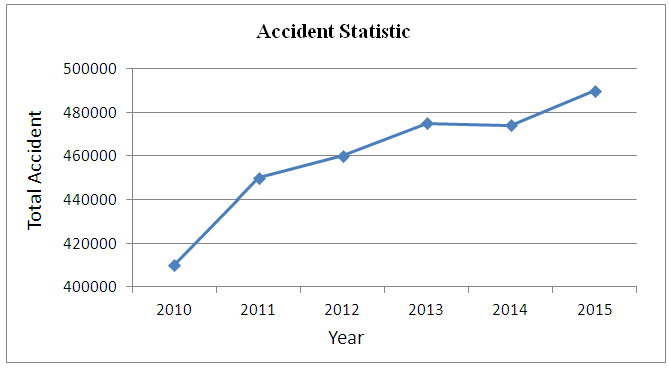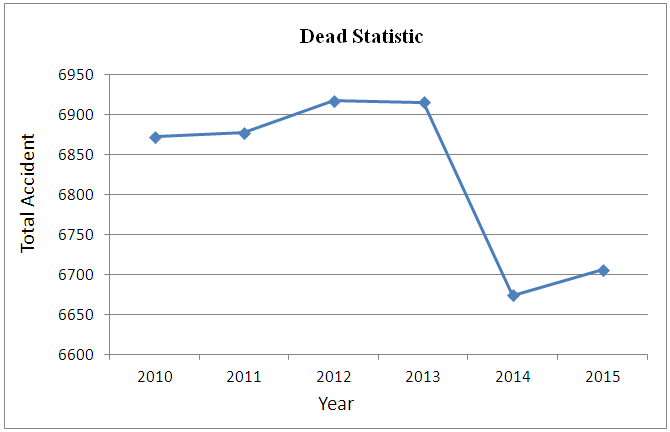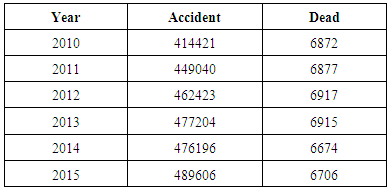-
Paper Information
- Previous Paper
- Paper Submission
-
Journal Information
- About This Journal
- Editorial Board
- Current Issue
- Archive
- Author Guidelines
- Contact Us
International Journal of Advanced and Multidisciplinary Social Science
2017; 3(1): 22-27
doi:10.5923/j.jamss.20170301.04

Analysis of Exhaustion Related Psychological Risk Factors among Oil and Gas Tanker Drivers in Malaysia
Selvarajah Krishnan1, Sheikh Muhamad Hizam2, Amirul Firdhaus2, Siti Sarah2, Ahmad Taufiq2
1International University of Malaya-Wales, Kuala Lumpur, Malaysia
2University Kuala Lumpur, Malaysia
Correspondence to: Selvarajah Krishnan, International University of Malaya-Wales, Kuala Lumpur, Malaysia.
| Email: |  |
Copyright © 2017 Scientific & Academic Publishing. All Rights Reserved.
This work is licensed under the Creative Commons Attribution International License (CC BY).
http://creativecommons.org/licenses/by/4.0/

The oil and gas segment assumes a fundamental part in the economic advancement in Malaysia. The transportation of oil and gas is a delicate issue that fact’s carelessness of a tanker driver cause expenses in an organisation. The purpose of this research is to investigate of oil and gas truck drivers' exhaustion is vital in the light of the fact that the vast of majority of the transportation exercises rely on upon them. Besides, the mental hazard variables (behaviour, personal traits and stress of work) highly affect drivers' exhaustion. This research also focus on identifying with substantial vehicles driver’s weakness working in oil and gas segment of Malaysia. The finding shown relationship between the psychological risk factors (behaviour, personal traits and stress of work) and exhaustion among the oil and gas tanker drivers were significant. Further, this will benefit all the drivers not just the lorry drivers, but all drivers. This research is to increase the awareness among the truck drivers to be in safety and safe on the road and minimize accident expenses for organisations. In this research, the methodology that we used is the secondary data which are we collected the data from the internet, journals, and newspapers.
Keywords: Psychological Risk Factors, Mental Fatigue, Tanker Drivers
Cite this paper: Selvarajah Krishnan, Sheikh Muhamad Hizam, Amirul Firdhaus, Siti Sarah, Ahmad Taufiq, Analysis of Exhaustion Related Psychological Risk Factors among Oil and Gas Tanker Drivers in Malaysia, International Journal of Advanced and Multidisciplinary Social Science, Vol. 3 No. 1, 2017, pp. 22-27. doi: 10.5923/j.jamss.20170301.04.
Article Outline
1. Introduction
- Fatigue has major implications for transportation system safety. Therefore, analysing the psychological behaviour links to fatigue could enhance on understanding and management of fatigue in the transport industry. Truck drivers will probably endure serious harm and demise because of certain truck driving qualities. As shown, Malaysia has the highest ranking of accident in the world. This is because most of the Malaysian habit is bad which is they intend to drive with bad psychological factors without considering the risks is the major cause of fatalities in Malaysia. This study intends to investigate the psychological factors with substantial vehicles drivers’ exhaustion working in oil and gas division of Malaysia. Excessive daytime sleepiness is recognized as a major public health problem that affects about 15% of the general population and can lead to impaired cognitive function, poor quality of life, and accidents (Hasler et al., 2005; Ohayon et al., 1997). Passenger vehicle drivers are responsible of majority of sleep-related crashes, but truck drivers are considered a priority target group for the prevention of drowsy driving and accidents (Lyznicki et al., 1998). It has been shown that sleepiness compromises vigilance and reaction time, psychomotor abilities considered essential for driving (Van Dongen et al., 2003). As well as increasing the likelihood that drivers will fall asleep at the wheel, fatigue could also impair driving ability such as maintaining road position and speed (Mackie & Miller, 1978). This shows that most of the accidents not just because of the fatigue but also effect by the psychological factors among the road user especially the tanker drivers that we are more focusing. The tanker drives should have been aware about the accident that happened among the road drivers. The factors like mental fatigue and the physical fatigue could have been increase the risk of fatalities among Malaysians. The fatigue will also decrease the drivers’ performance that will also led to the fatalities that can affect the drivers and all the road users. It is because the tanker drivers are the heavy truck drivers. Behaviour of the drivers also important to decrease the fatalities. The drivers of the tanker should have considered about other road user like others small drivers like motorcycle and the cars.
2. Literature review
2.1. Psychological Risk Factors and Drivers Fatigue
- Psychological risk factors must be focused in the cause of accidents that happened daily. Today, fatigue has become a major problem in occupational activities involving late-evening and night shifts. Many characteristics associated with truck driving, such as truck weight, high mileage exposure, level of attention demanded, and monotony of the task of driving, could contribute to why these workers are more likely to suffer severe injury and death in an accident (Häkkänen Q2 and Summala, 2001; Morrow and Crum, 2003). Truck drivers are involved in many traffic accidents that cost high to the health and insurance systems (McCall and Horwitz, 2005). The early introduction to the subject by Grandjean (1979, 1988) defined fatigue as a state marked by reduced efficiency and a general unwillingness to work. Later, Brown (1994) in a review of driver fatigue, defined fatigue as a subjectively experienced disinclination to continue performing the task at hand. Analysis of accident data suggests that driver-related fatigue is implicated in road accidents, particularly at night (Haworth, Heffernan, & Horne, 1989; Mackie & Miller, 1978) and during long driving hours (Hamelin, 1987; McDonald, 1984). During fatigue, the decreased physiological arousal, slowed sensorimotor functions, and impaired information processing can diminish a driver’s ability to respond effectively to unusual or emergency situations (Mascord & Heath, 1992). A study of truck drivers also reported cortical deactivation and increased sleepiness during the end hours of an all-night driving shift (Kecklund & Åkerstedt, 1993). In 24 hours of operations and with widespread automation, risks of fatigue-related accidents are increased (Dinges, 1995). Fatigue or sleepiness is frequently reported in night-time drivers (Torsvall and A, kerstedt, 1987) and is thought to be a major factor in accidents occurring in monotonous driving conditions (Horne and Reyner, 1995c). Driving or working for a sustained period of times can increase fatigue, reduce productivity, and alter cardiovascular and neurophysiological functions (Smith, 1981; Schliefer and Okogbaa, 1990; Okogbaa et al., 1994).
2.2. Mental Fatigue and Physical Fatigue
- Mental fatigue has been also one of the causes of fatalities among the truck drivers. According to Grandjean (1979), the state range from deep sleep, light sleep, drowsy, weary, hardly awake, relaxed, resting, fresh, alert, very alert, stimulated and a state of alarm. Such type of symptoms of mental fatigue among heavy vehicle tankers’ drivers impact on the driving performance of drivers (Sung et al., 2005). The reduction of performance of a muscle after due to stress is called physical fatigue. It is characterized by reducing the power of muscle and their movement. The impaired muscular fatigue increased the chance of accidents (Grandjean, 1988). On the flip side, the physiological activities are diminishing during the daytime of driving. There are many other factors that affect the performance of heavy vehicle drivers. One of them is continued driving without taking any rest. The indicators of driving performance influence on commercial driver’s performance such as speed perception, depth perception number of incorrect action judgments, attention allocation value choice reaction time and number of correct light reactions (Wang and Pei, 2014). The link is also well established between acute sleep loss and increased sleepiness and impaired waking function (Bonnet, 2000; Carskadon & Roth, 1991). For most people, getting 2 hours less sleep than they need on one night (an acute sleep loss of 2 hours) is enough to consistently impair performance and alertness the next day. The reduction in performance capacity is particularly marked if less than about 5 h sleep is obtained (Carskadon & Roth, 1991; Connor et al., 2002; Horne, 1991). Circadian disruption and sleep deprivation can also lead to reduced waking alertness, impaired performance, worsened mood and fatigue (Bonnet, 1985). Fatigue during driving is a serious problem in transportation systems and is believed to be a direct or contributing cause of road related accidents (Gander et al., 1993). Analysis of accident data suggest that fatigue is implicated in road accidents, particularly at night (Mackie and Miller, 1978; Haworth et al., 1989; Kecklund and A, kerstedt, 1993) and in situations in which driving hours are very long (McDonald, 1984; Hamelin, 1987).
2.3. Tankers Drivers’ Fatigue and Driver’s Performance
- Tanker drivers’ fatigue is a major contributor of drivers’ errors. The fatigue occurs when the physiological activities increased and influenced the performance of drivers (Nilsson et al., 1997). Fatigue is dangerous in that people are poor judges of their level of fatigue. The following is a sample of fatigue’s known effect on performance (IMO, 2001). Fatigued individuals become more susceptible to errors of attention and memory (for example, it is not uncommon for fatigued individuals to omit steps in a sequence), chronically fatigued individuals will often select strategies that have a high degree of risk on the basis that they require less effort to execute, fatigue can affect an individual's ability to respond to stimuli, perceive stimuli, interpret or understand stimuli, and it can take longer to react to them once they have been identified, fatigue also affects problem solving which is an integral part of handling new or novel tasks. (IMO, 2001). Excessive work hours and fatigue can result in negative effects such as the following (IMO, 2001); Increased accident and fatality rates, increased dependence upon drugs, tobacco or alcohol, poor quality and disrupted sleep patterns, higher frequency of cardiovascular, respiratory, or digestive disorders, increased risk of infection and loss of appetite.
2.4. Identification of Fatigue Source among Oil and Gas Tanker Drivers in Malaysia
- As stated in research methodology, there are various variables that affecting fatigue. These variables are identified to be affecting tanker driver working manner which in the negative way can lead to the worst effect in oil and gas industry. The variables that have been categorized are of general terms and do not represent the fatigue of tanker drivers in Malaysia. Due to the reason, the variables affecting driver tankers of fatigue need to be identified first to further develop this study. To do this, a review of previous literatures must be made and then the identification of fatigue variables of Malaysian tanker drivers can be done.According to the previous research which done by Asrar Ahmed Sabir (2015), the sources of fatigue among tanker drivers in Malaysian are:• Mental Fatigue: A feeling of weariness might not be unhappy if one can be rested, but it could be disturbing an individual if the individual cannot be relaxed (Grandjean, 1988).• Physical Fatigue: The hard physicals of work before driving can be increasing the risk of accidents among drivers and experiencing the physical fatigue during the driving (Strand and Rodahl, 1986).• Drivers Fatigue and Psychological Factors: Three types of psychological factors will be applied to assess the drivers fatigue such as personality traits, driving behaviors and work stress. The aged employees are less addicted of drugs and more concentrated as compared to the young drivers (Adrian et al., 2011).• Fatigue and Drivers Performance: The fatigue occurs when the physiological activities increased and influenced the performance of drivers (Nilsson et al., 1997).
3. Methodology
- Data collection focused on two types of data collection, namely the primary data and secondary data. Formerly, want to get data depends on the distribution of questionnaires to subscribers only. Secondary data include information that has been collected and is probably related to the problems faced. The primary data of collection using observations or experiments data is to solve problem under the investigations.
3.1. Secondary Data
- Secondary data were obtained by searching through journals, newspapers and published articles, magazines and through the website on the internet. This type of data has been collected as supporting documents as well as evidence of the problems that have been documented in this research. Secondary data include information that has been collected and is only possible regard to problems only. Secondary data is useless because most of the information provided are good understanding and clearly.
3.2. Previous Studies
- Information can be obtained through previous studies on Assessing the Fatigue Related Psychological Risk Factors among Oil and Gas Tankers Drivers in Malaysia and help us to continue this study.Two relatively recently published papers provide a comprehensive review of current methodological approaches for studying crash frequencies, the number of crashes on a roadway segment or intersection over some specified time period (Lord and Mannering, 2010), and crash severities, usually measured by the most severely injured person involved in the crash (Savolainen et al., 2011)
|
3.3. Holistic Overview with Malaysian Perspectives
- The holistic overview describes fatal crashes and fatalities from 2010 to 2015 in Malaysia. According to the report of the Official Portal of Road Transport Department Malaysia, the road crashes were increasing with the passage of time. The fatigue-related fatal road crashes in Malaysia were caused by heavy vehicle drivers (Tan Yi Liang, 2015). This study put emphasis on the work-related fatigue among heavy vehicle drivers.The Figure 1 describes fatal crashes and fatalities from 1997 to 2013 in Malaysia. This is general road accident data retrieved online November 2015. According to a survey, the number of road fatalities and fatal crashes between light and heavy vehicles reached an alarming stage in Malaysia. The holistic overview described fatal crashes and fatalities from 1997 to 2013 in Malaysia. According to the report of the Official Portal of Road Transport Department Malaysia, the road crash is increasing with the passage of time. The fatigue-related fatal crashes caused by road fatalities among heavy vehicle drivers in Malaysia (Mohamed et al., 2012). This study emphasizes the fatigue related psychological risk factors among tanker’s drivers in Malaysia.Figure 1 shown, the graph of accident is increasing starting from 2010 until 2015. The highest increase amount of accident is on 2010 to 2011.
 | Figure 1. Holistic Overview with Malaysian Perspectives for Accident Statistic |
 | Figure 2. Holistic Overview with Malaysian Perspectives for Dead Statistic |
|
4. Conclusions
- Fatigue is potentially dangerous for the transportation industry. This research is examining the methods that our research. This research also included the very detail about the fatigue, the effect of fatigue and the example of fatigue. It is also shows that fatigue is gives a big impact to the road users. The fatigue-related fatal crashes caused by road fatalities among heavy vehicle drivers in Malaysia (Mohamed et al., 2012). This research shows that fatigue is a possibly dangerous transport related condition. In this manner, weakness countermeasures are required that could give an essential answer for fatigue related fatalities.During this research, we have severe of limitations. We do not have enough time to complete this research in very detail. Besides we could not do the interview at the tanker drivers to increase the methods we should have been used. Future research will be increase in methods like interviews and questionnaires among the road users.
 Abstract
Abstract Reference
Reference Full-Text PDF
Full-Text PDF Full-text HTML
Full-text HTML
